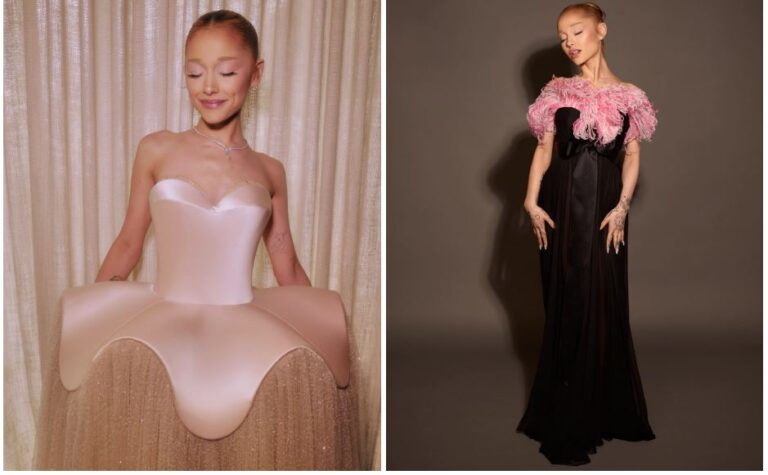Ariana Grande’s notably slimmer appearance has generated a lot of discussion on social media and in entertainment news over the last two years. Her path to physical transformation, however, doesn’t neatly fit into a hashtag or headline. It has its roots in a purposeful, all-encompassing move toward healing rather than in diet fads or vanity. Many people, whether or not they are famous, can identify with her transformation because it shows how someone actively confronts personal trauma, embraces mental clarity, and regains peace.
She responded to mounting rumors in April 2023 by sharing an emotional TikTok video. Her quiet yet incredibly honest voice clarified what many people tend to forget: the body she once praised by fans was, in her own words, the worst she had ever been. She talked about drinking excessively, eating poorly, and taking antidepressants. She was quietly going through one of the worst times of her life, even though she seemed “healthy” to others.
Ariana Grande – Bio and Personal Overview
| Full Name | Ariana Grande-Butera |
|---|---|
| Date of Birth | June 26, 1993 |
| Age (2025) | 32 |
| Nationality | American |
| Profession | Singer, Actress, Beauty Entrepreneur |
| Estimated Net Worth | $220 million |
| Notable Projects | Wicked, Eternal Sunshine, R.E.M. Beauty |
| Reported Partner | Ethan Slater |
| Major Health Events | PTSD, Anxiety, Grief, Public Scrutiny |
| Focus Areas | Mental Health, Body Positivity |
Grande’s more fragile body has been prominently displayed at high-profile events like the Oscars and the BAFTAs in recent months, especially during awards season. She appeared calm, even radiant, in couture gowns that shimmered in the light of flashing cameras. However, criticism regarding her weight increased with each public appearance. Google searches for terms like “Ariana Grande skinny” skyrocketed by the time she walked the red carpet alone for Wicked.
Though possibly expected, the response draws attention to a recurring problem: our apprehension about change, particularly when it is obvious. She is used to being scrutinized. In a recent interview with French journalist Salima Jeanne Poumbga, Grande used the metaphor that she has been scrutinized and dissected like a “specimen in a petri dish” since her early Nickelodeon days. Her words weren’t premeditated; rather, they were introspective and depicted a person who has been quietly redefining herself while living under a microscope for years.
It’s critical to comprehend the true nature of this evolution. Extremely traumatic incidents have dotted Grande’s recent years. She was shaken by the 2017 Manchester Arena bombing at her concert, which caused her to experience frequent panic attacks, dizziness, and disorientation. A year later, she experienced yet another wave of grief following the passing of her ex-partner Mac Miller. She has acknowledged the long-lasting emotional toll of both incidents in a number of interviews and lyrics. That grief doesn’t just go away; it persists in the body, frequently in ways that are invisible to others.
During that period, therapy was an anchor for her. Her personal anthem for healing was the heartfelt ballad “Get Well Soon,” which she co-produced with Pharrell Williams. There were layers of hope mixed with sadness in each verse. It’s a declaration of survival rather than merely a song. Grande created a type of rhythm therapy by expressing her feelings through music, employing lyrics and sound as means of regaining her composure.
Her schedule was made more complicated by her role as Glinda in Wicked. Her schedule was filled with vocal training, physically taxing rehearsals, and international promotion. She also kept up her relationship with co-star Ethan Slater and managed her beauty brand, R.E.M. Beauty. Insiders claim that because of these combined demands, her routine became extremely erratic, with her eating at strange hours, working herself to exhaustion, and sleeping only when it was feasible.
The ensuing physical adjustments were a component of a much more extensive emotional realignment. Grande, in contrast to many of her contemporaries, has refrained from endorsing any particular diet or weight-loss program. Despite rumors, she has not mentioned drugs or fashions like Ozempic. That quiet is a boundary, not an avoidance tactic. Her message is not about spectacle but about health. Intentional living, not a carefully manicured appearance, is the key.
In this regard, Grande has become a particularly creative voice in the larger discourse surrounding body image and fame. She isn’t selling transformation plans or quick fixes. She is urging audiences to stop using waistlines as a gauge of wellness instead. Her TikTok video and the interviews that followed questioned the idea that change always indicates a crisis or that smaller is better.
We have a big say in how that conversation is shaped as viewers, reviewers, and commentators. The media focused more on her appearance than her performance at the Oscars, even though she was nominated for Best Supporting Actress. That incident acted as a reminder that women’s bodies are still disproportionately discussed, even in times of victory. Grande also made it very apparent that she will no longer put up with uninvited criticism of her appearance, despite her poise and politeness.
She gives straightforward and useful advice to others: keep your space safe. Stop the trolls. Unfollow the voices that are harmful. If necessary, remove the app. Questions like “Why do you look so thin?” may seem innocuous, but they frequently have unintended consequences, whether they are asked at a family dinner or on the red carpet. Grande’s stance is both empowering and protective. She promotes unapologetic personal boundaries.
Her candor has aided in changing the way that younger audiences—particularly women and girls—perceive public opinion and weight loss. She is emphasizing the entire in-between—the messy, honest part of healing—by eschewing before-and-after clichés. Therapy, healthier eating, self-care, and peaceful days away from the spotlight are all included in that section.


1 Comment
I don’t think the title of your article matches the content lol. Just kidding, mainly because I had some doubts after reading the article. https://accounts.binance.info/ph/register-person?ref=IU36GZC4